
Article contents

You don’t need to decide between them, you can have both! A good idea is to use a workplace pension to get free cash from your employer (3% free if you save 5%), and then save more into a personal pension, where you can pick a great pension provider, have full control over your pension, and how you want it to grow over time (e.g. with the experts managing it).
Planning to save a bit more for retirement? Great idea. A private pension and workplace pension are both great options, and with both you’ll be able to save tax-free too, but is one the better option for you? Or is having them both the best idea? Let’s find out.
Note: although we’ve called it a private pension, we’re actually talking about personal pensions. A private pension is simply a pension that’s in your name (private to you), so workplace pensions and personal pensions are both types of private pensions – the difference is one is set up by your employer (a workplace pension) and the other is set up by you (a personal pension).
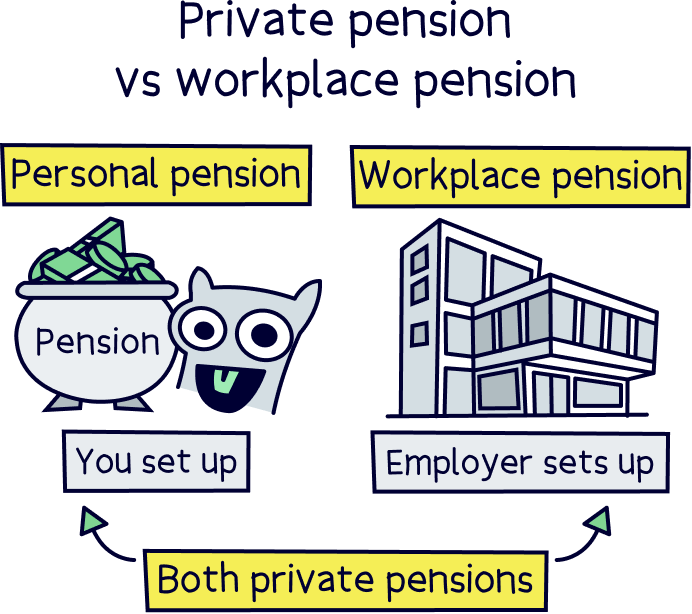
As a general rule, a great set up to save for a comfortable retirement (if you’re employed), is to pay as much into your workplace pension that would get you the most free cash from your employer (more below), and then start paying into a personal pension – where you have much more control over your pension, such as which provider (company) to use, where your money is invested, and improved ways to manage your money (e.g. a great mobile app), and able to choose a provider with better customer service.
With a workplace pension, by law, if you pay in 5% of your salary, your employer has to pay in 3% – and sometimes if you have a very nice employer, they might pay in more, if you pay in more too.
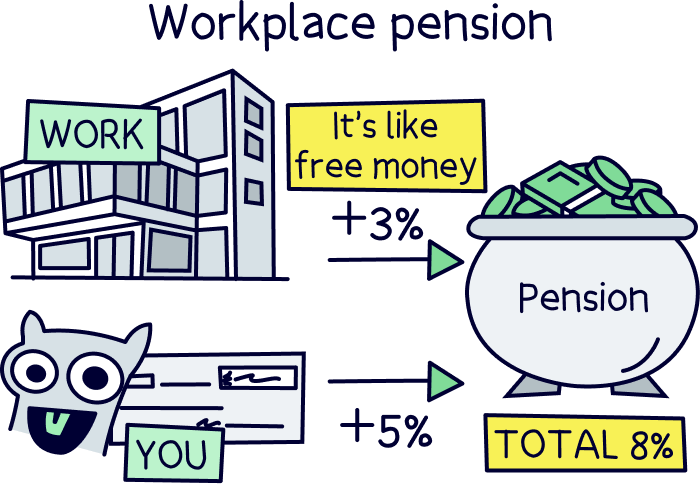
So, you should aim to pay in as much as possible to get the most free cash out of your employer (for instance, if they match your contributions up to 7%, pay in 7%).
After that, it’s typically a good idea to start saving into a personal pension…
PensionBee tops the list, it’s easy to use, has low fees and a great record of growing pensions over time.
Note: we’re talking about defined contribution pensions, which are pensions that you pay into from your salary, and build up a pension pot with a total value. The main alternative is a defined benefit pension, which is common in government jobs and the NHS. These are where you’ll get a set retirement income when you retire, and typically don’t pay into a pension pot throughout your career (you can still save into a personal pension).
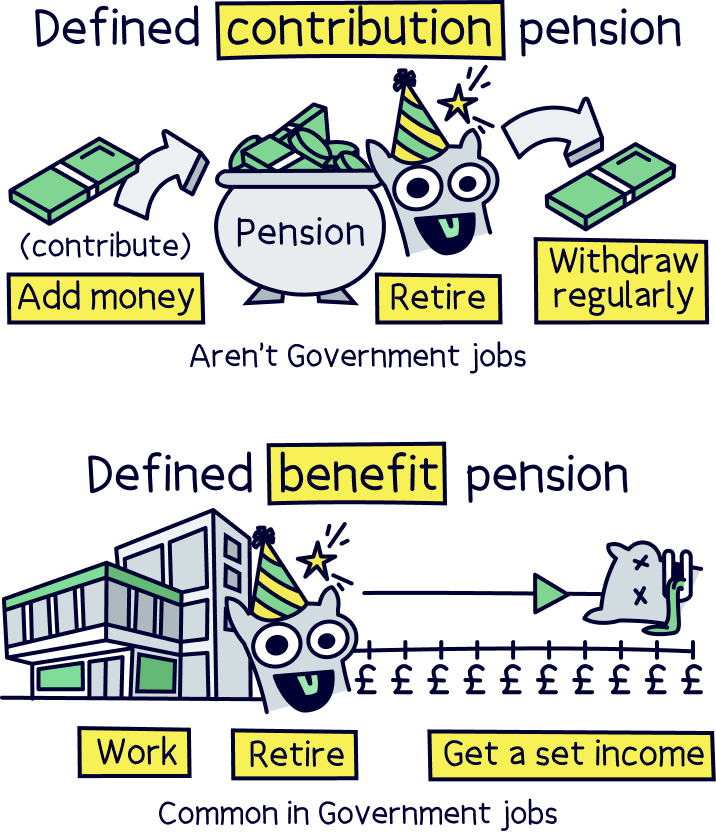
With a personal pension, you get all the same tax-free benefits, which we’ll cover below, but you get the added benefit of being able to choose which pension provider (company) you’d like to use, so you can pick one that suits you – perhaps one that’s easy to use, has low fees and a great record of growing pensions over time.
These days, modern pension providers even have great mobile apps so you can manage and check your pension whenever you like. And you’ll struggle to find better customer service with some of the best ones (something that tends to lack with workplace pensions).
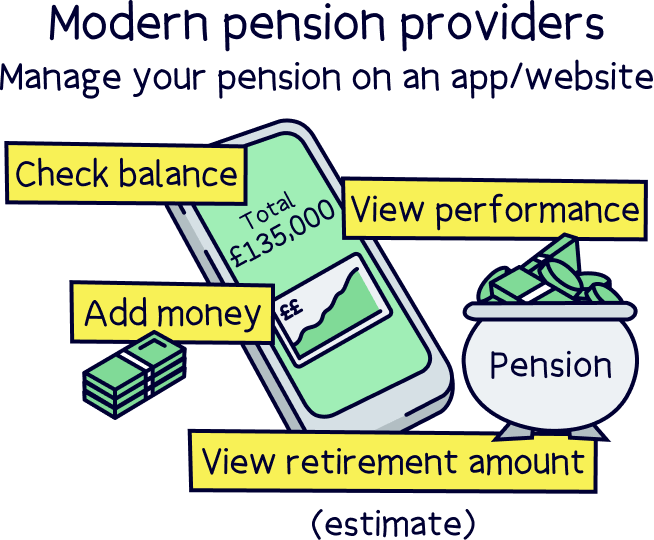
Nuts About Money tip: if you’re keen to get started with a personal pension, check out PensionBee¹, for all those reasons above. And, we’ve managed to bag you £50 added to your pension for free with Nuts About Money.
Plus, you’re able to transfer your personal pension to another provider whenever you like, so you always stay with a provider you’re happy with.
With a workplace pension, you’re not able to transfer it anywhere else until you leave your current job (and then you can transfer it to a personal pension if you like).
There can be instances when you’d want to keep paying more into a workplace pension rather than opt for a personal pension, and that’s if you got a special type of workplace pension called ‘salary sacrifice’.
This is where your employer will reduce your salary, and pay the difference into your pension instead. Doing this would mean paying less National Insurance.
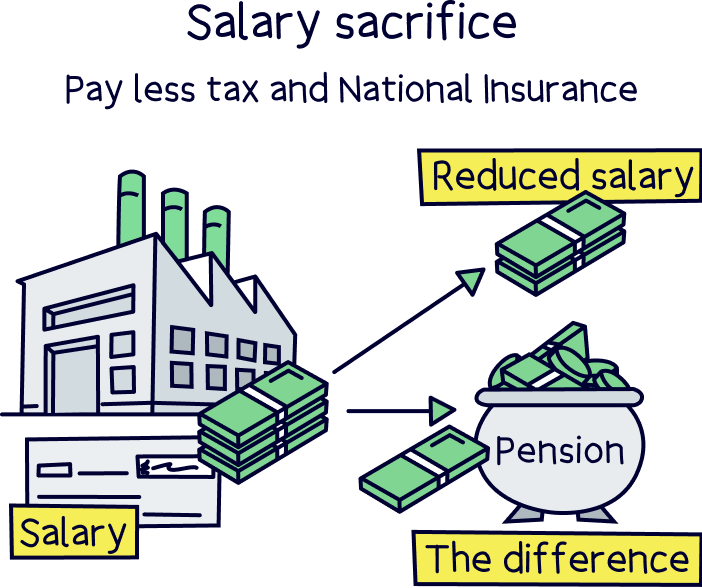
However, it may not be right for you even if it’s on offer, depending on things like which workplace pension provider you’re using (which you may not like for a variety of reasons), and it will reduce your total salary so could affect things such as how much you can borrow for a mortgage or loan, and the level of life insurance cover (which can be based on your salary).
It may also affect your future benefits if your salary falls below how much you’d need in order to be making the right amount of National Insurance contributions. This can affect things like the State Pension (the government pension) and State Maternity Pay (pay after having a baby).
You also can’t reduce your pay below the minimum wage.
Easy to use, with low fees and great customer service.
Get £50 added to your pension



PensionBee is our recommended provider – they’ve thought of everything.
Their 5 star rated app (and website) makes it easy to set up and use. You can open a brand new pension, or transfer your existing pensions across (they’ll handle all the paperwork).
Simply pick from an easy to understand range of pension plans, and that’s it, the experts manage everything from there.
It’s low cost, with one simple annual fee. The customer service is excellent, and you’ll get a dedicated account manager for any questions you might have.

And, when the time comes to retire, withdrawing from your pension is easy too.
You can also use them if you're self-employed or a company director.
Great app



A great and easy to use pension. Add money from your bank or combine old pensions into one, (they’ll find lost pensions too).
The customer service is excellent, with support based in the UK.

Beach is an easy to use pension app (and easy to set up), where you just add money and the experts handle everything. It’s all managed on your phone with a great app, and you can see your total pension pot whenever you like.
If you’ve got lost or old pensions, Beach can also find them and move them over too, so you can keep all your retirement savings in one place, and never have to worry about losing them in future.
You’ll get an automatic 25% bonus on the money you add to your pension pot from your bank account (tax relief from the government), which refunds 20% tax on your income, and if you pay 40% or 45% tax, you’ll typically be able to claim the extra back too.
The pension plan (investments) are managed by experts, who are the largest investment company in the world (BlackRock). And they consider things like reducing climate change, meaning your savings could make the world a little better in future too.
You can also save and invest alongside your pension with an easy access pot (access money in around a week), designed for general savings, with the investments managed sensibly by experts too. And money made can be tax-free within an ISA.
Fees: a simple annual fee of up to 0.73% (minimum £3.99 per month).
Minimum deposit: £25
Customer service: excellent
Pros:
Cons:
PensionBee tops the list, it’s easy to use, has low fees and a great record of growing pensions over time.
Let’s dive into workplace pensions a bit more so we’re all on the same page.
A workplace pension is a pension set up by your employer, often called auto-enrolment. They’ll pick which pension provider you’ll use, and then typically, you’ll pay 5% of your salary, and they’ll pay in 3% (by law).
For this reason, workplace pensions are pretty great, as you’ll get the extra cash from your employer, so it’s like a payrise.
And sometimes, your employer might have a scheme called ‘salary sacrifice’, which is where they’ll reduce your actual salary figure on your payslip, and pay the difference between what you should get paid, and what you actually get paid, into your pension. This means you’ll pay less National Insurance contributions too. You won’t normally pay any less tax, as paying into a pension is tax-free already.
The downside to workplace pensions is that you don’t get much control over your pension yourself, you can’t decide which pension provider to use, and you can’t transfer your pension to another provider until you leave your job.
That means you won’t be able to put your pension exactly where you want to (which pension plan to save into, or investments to make), and you might not get things modern providers offer, such as a great mobile app to keep track of your pension.
By the way, we’re talking about defined contribution pensions, which are common in most workplaces – where your money comes out of your salary and put directly into your pension pot, and this pot builds up over time (and has a financial value).
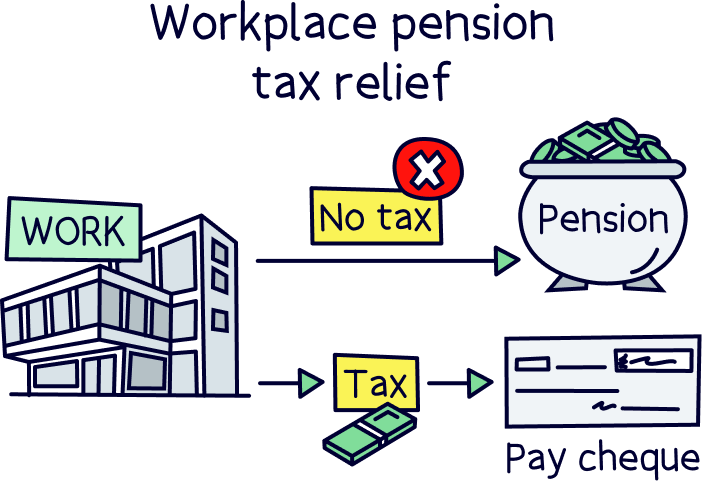
There’s another type of pension in workplaces, called a defined benefit pension, and common in public jobs, such as the government and NHS. This is where you get a guaranteed income when you retire, based on things like your salary, and how long you’ve worked there (they can be called final salary pensions, or average salary pensions).
With these, you might be able to pay more in to get a bigger retirement income, but you might not too – it’s best to speak to your employer. If you can’t, or don’t want to, you’ve got the option of a private pension (personal pension) to save more for retirement.
We’ll use the term private pension here, as that’s what most people call a personal pension – which is a pension you set up yourself, rather than your employer (but both are actually types of private pensions).
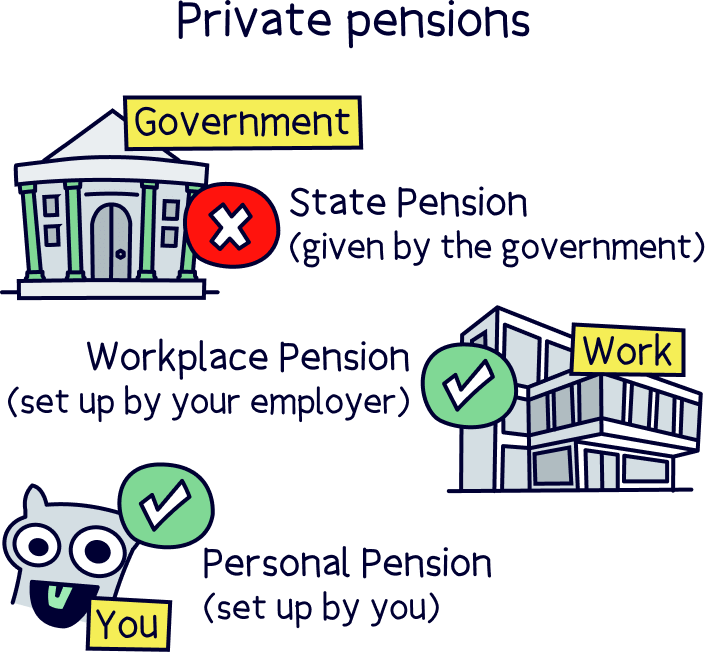
A personal pension has lots of great benefits, and the ability to have lots more control over your pension pot than a workplace pension.
You’ll be able to save tax-free, but you won’t be paying into your pension directly from your salary (like a workplace pension), instead you’ll get paid, and then pay into your personal pension, which means you would have paid tax on your income…
So, to give you back the tax you’ve paid, the government will give you a 25% bonus directly into your pension pot, whenever you add money. Pretty great right? This is technically called tax relief.
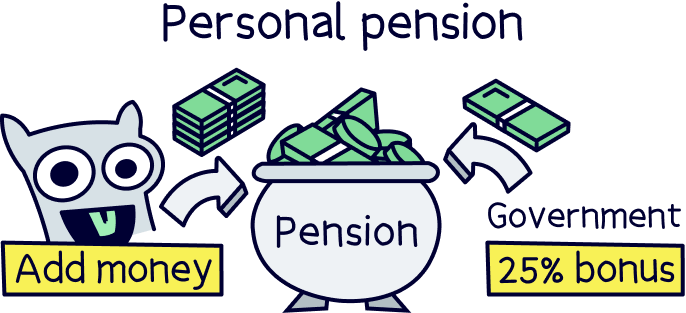
And if you’re a higher rate taxpayer (40%), or additional rate taxpayer (45%), you can claim back some of the tax you’ve paid at these rates too, by visiting the government’s online pension tax relief tool, or on your Self Assessment tax return if you do one. If you want help with your Self Assessment tax return, Taxfix¹ can help, their service is low cost and 5* rated.
You can pick whichever pension provider you like (from those who offer personal pensions), and decide how much you’d like to pay in, when to pay in, and later when to withdraw from it.
You’ll be able to withdraw from it from age 55 (57 from 2028) if you want to, and 25% will typically be completely tax-free. With the remaining 75%, you might pay Income Tax when you withdraw it, it depends on your total income at the time (this is the same as workplace pension schemes too).
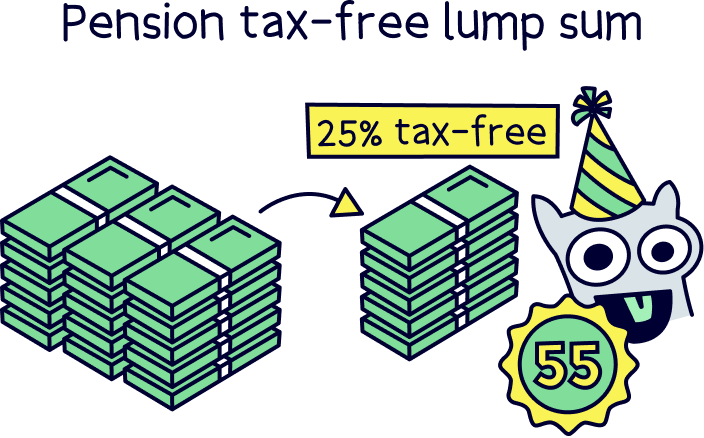
And if you’ve got lots of old pensions lying around collecting dust, you can transfer these to a personal pension, so they’re all in the same place too. This is called consolidating your pension.
If you’re an experienced investor, you also have the option to make your own investments within a self-invested personal pension, or SIPP. Learn more about those with our guide to the best SIPP providers.
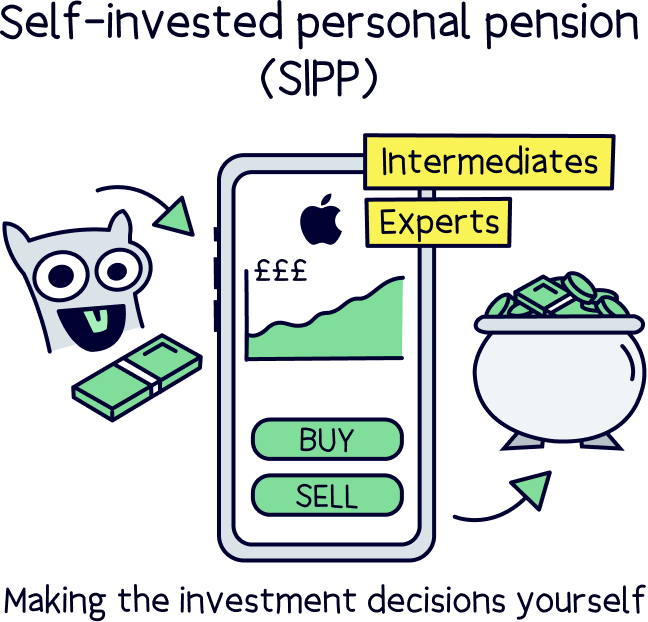
If you’re self-employed, a personal pension is pretty much your only pension option to save for retirement, but a really great one.
You can save as and when you like, or set up regular payments, such as monthly, and with a modern pension provider, let the experts handle things, aiming to grow your pension very large over time. If you are self-employed, check out our guide to self-employed pensions.
Which one is right for you then? Well, here’s the thing, you don’t need to pick between them. You can have both!
A very sensible strategy to save for retirement is to make the most of both pensions, and here’s how.
First, if you are employed, make the most of the free money you’ll get from your employer when you save into a workplace pension scheme. If you pay in 5%, your employer will typically have to pay in 3% too – a great bonus for your pension.
After that, if your employer pays in more if you pay in more, then it could be a good idea to pay in more to get extra free cash. This is sometimes called matching your contributions, for instance, if you pay in 8%, your employer might increase their contributions to 8% too.
And if they offer a salary sacrifice pension, you could consider saving more into your workplace pension to reduce your National Insurance bill too.
They’re the key benefits to a workplace pension, but as there are some drawbacks to a workplace pension, for instance you don’t get to decide which pension provider to use, it can be a good idea to now save into a personal pension, after you’ve maxed out all the employer benefits.
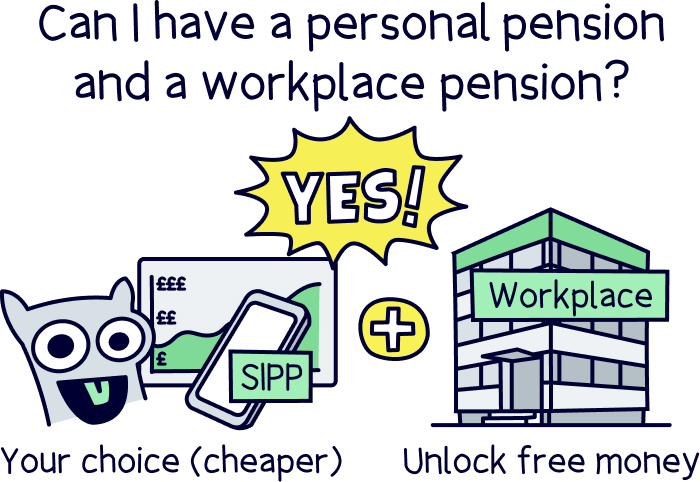
That way you have full control over your pension, so things like deciding which pension provider you’d like to use, so you can pick one that’s easy to use, and has low fees, and decide where your money is saved and invested. Plus, you can transfer your pension to a different provider wherever you like, so your pension can always be where you want it to be – with a top provider, growing in the way you’d like.
You can move all of your old pensions over to your new personal pension too, so you can keep all your pensions in one place (except the pension from your current job, but you can move that over when you get a new job). That way, you’ll never forget where your pension is, when the time comes to retire, which happens a lot more than you might think!
If you’re not sure where to find a great personal pension provider, check out PensionBee¹, it’s easy to use, low cost and has a great record of growing pensions over time. You’ll also get £50 added to your pension for free with Nuts About Money. For all the top options, check out the best private pensions.
Hopefully you’ve built up a nice big pension pot all ready for retirement, and that comfortable retirement you deserve is all yours.
From the age of 55 (57 from 2028), you’ll be able to withdraw from your private pensions (so that’s both a workplace pension and a personal pension). Although it’s often a good idea to keep it growing for a bigger retirement income when you do actually retire.
You can also take 25% of it completely tax-free, and take it as a tax-free lump sum if you like. You might pay tax on the remaining 75% depending on your total income at the time.
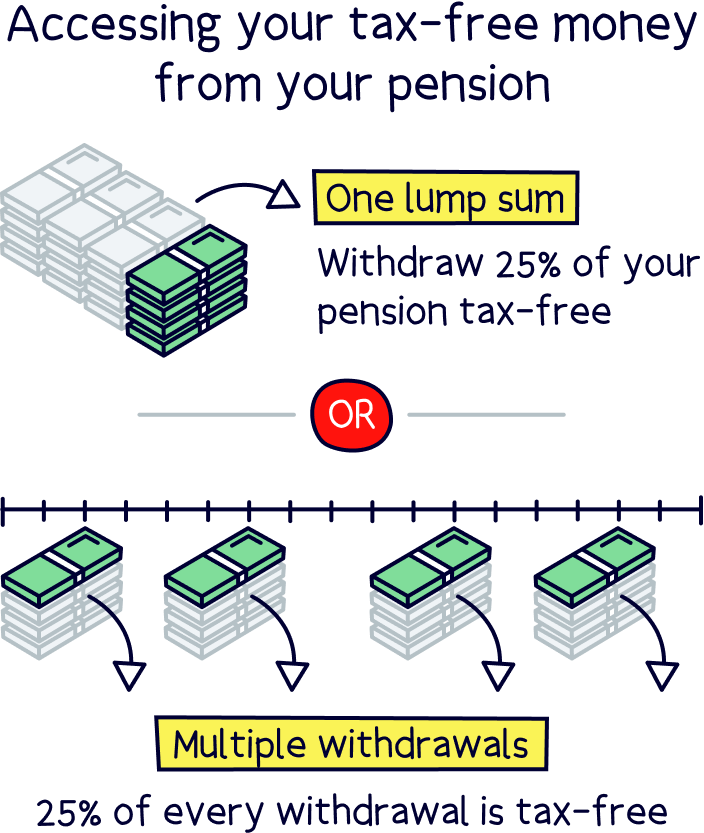
When you do retire, there’s two main options for withdrawing cash, either simply withdrawing cash straight from your pension pot as and when you like (for instance month), which is called pension drawdown. The rest of your money can keep growing while in the pension pot too.
Or, you can opt for a pension annuity, which is trading your pension pot in for a guaranteed income for the rest of your life, or a set number of years (e.g. 20 years). Or, you can do a bit of both.
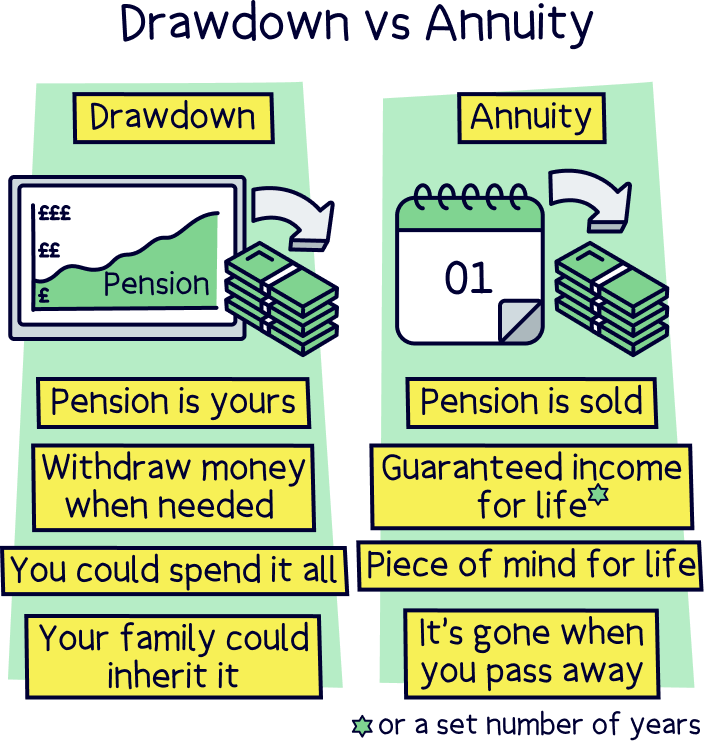
To learn more about each option, check out our guide to pension drawdown vs annuity. And, get free pension advice from Pension Wise.
Nuts About Money tip: if you think drawdown might be for you, here’s the best pension drawdown providers.
Yep, saving into a private pension, whether that’s a workplace pension, or a personal pension, is perfectly safe.
All pension providers need to be authorised by the Financial Conduct Authority (FCA) in order to offer a pension. They’re the people who make sure your money is well looked after.
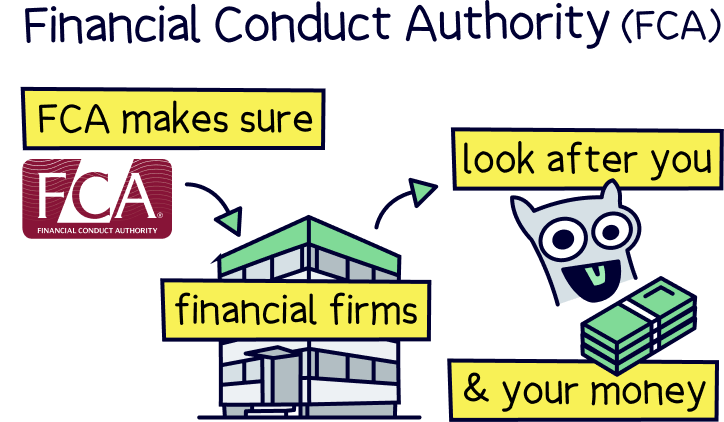
That also means you’re protected by the Financial Services Compensation Scheme (FSCS), which can provide up to £85,000 in compensation, and sometimes more for pensions, should anything happen to the pension provider, such as going out of business, and any of your money not returned to you.
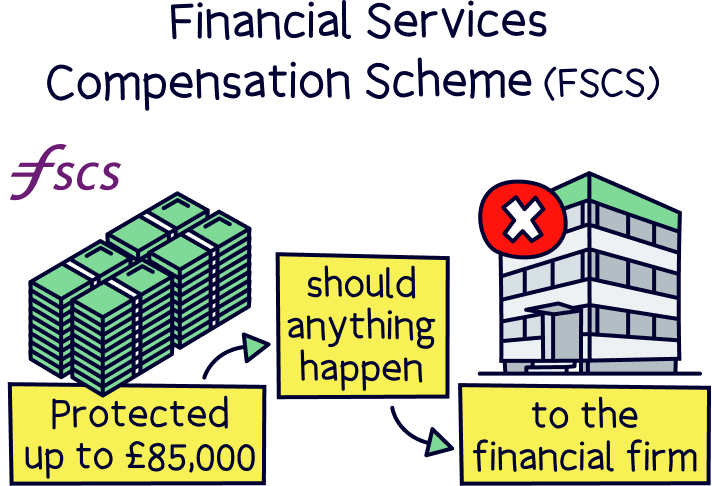
However, your money is typically within the investments within your pension, and these are held with very large banks and financial companies, all in your name, and can only be returned to you.
That doesn’t mean your money can go down in value. Your pension will typically go up and down in value over time while it grows, but will typically grow very large over time.
There we have it for workplace pensions vs private pensions. You don’t really need to pick between one or the other, you can use both as part of your retirement savings plan.
If you are employed, it’s a good idea to make use of all the free cash you can get from your employer by paying into a workplace pension (e.g. free 3% from your employer, if you pay in 5%).
If your employer won’t pay any more in, it can then be a great idea to continue saving into a personal pension – where your pension is all under your control, and you can pick a great pension provider, perhaps one that’s easy to use, has low fees and a great record of growing pensions over time.
You’ll still benefit from all the lovely tax-free saving benefits, it just comes in the form of a government bonus added directly to your pension pot when you contribute (or claiming it back on a Self Assessment tax return), rather than saving directly out of your salary tax-free.
You can even transfer your old work pensions across to your personal pension, and transfer it to a new provider again later down the line if you want to.
You’ll be able to decide where your pension is invested so it can grow over time, which you can do by simply leaving it to the experts, or making your own investments (via a self-invested personal pension).
As a reminder, our top picks for pension providers are PensionBee¹, for all those reasons above, and Beach¹, if you want to save and invest outside of your pension (like an ISA too). For all your options, here’s the best pension providers.

And that’s it. All the best for saving for your retirement.
PensionBee tops the list, it’s easy to use, has low fees and a great record of growing pensions over time.
PensionBee tops the list, it’s easy to use, has low fees and a great record of growing pensions over time.
We’d love to hear from you, and it will help others too.
PensionBee tops the list, it’s easy to use, has low fees and a great record of growing pensions over time.